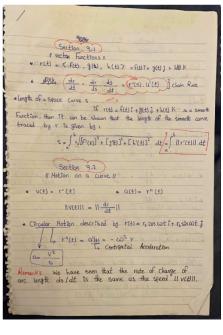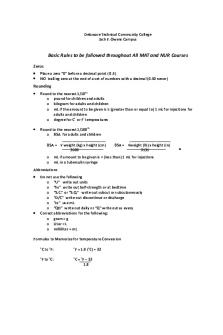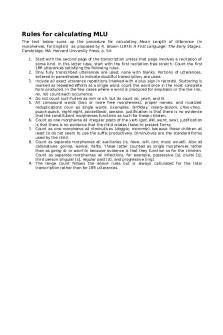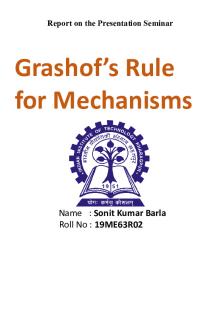Rules for naming alkanes-2018 PDF

| Title | Rules for naming alkanes-2018 |
|---|---|
| Author | Michael Foster |
| Course | Organic Chemistry I |
| Institution | Georgetown University |
| Pages | 3 |
| File Size | 189.2 KB |
| File Type | |
| Total Downloads | 36 |
| Total Views | 152 |
Summary
Rules for naming Alkanes...
Description
RULES for naming ALKANES (2018): 1) Find the longest continuous chain of carbon atoms and use the name of this chain as the “ Base” name of the compound. - when there are two equal-length possibilities, use the one with the greatest number of substituents. - If cycloalkane(s) is/are present, then they take precedence not matter how small; use the (largest) “cycloalkane” as the base name. 2) Number the carbon atoms of the longest chain (or cycle) so as to give the lowest set of locator numbers to the substituents (The lowest set is the one providing the lowest locator number at the first point of difference between possible choices. E.g., 1,1,3 substitution is better than 1,3,3 substitution.) - If (and only if) the locator numbers cannot differentiate, then prioritize numbering alphabetically according to substituent names (see below for alphabetizing rules). 3) Identify and name each substituent group attached to the chain. Hydrocarbon groups are called alkyl groups. Use the numbering to indicate the position of each alkyl group on the main chain. - common names for several substituents are expected to be used (isopropyl, isobutyl, sec-butyl, tert-butyl) and common names for substituents up to five carbons can be used (isopentyl [or ‘isoamyl’], neopentyl, tert-pentyl) but I don’t expect you to know the 5carbon ones. Use hyphens to separate numbering and substituents. Use italics according to how you see it above. - name a complex substituents as if they were a compound themselves, but put “yl” at the end. Use parentheses to surround and set apart complex substituent names. E.g, 3-(1,1,2-trimethylbutyl)-yadayadayada - –OR and –X substituents are called “alkoxy” (e.g., methoxy, ethoxy) and “halo” (fluoro, chloro, bromo, iodo), respectively. 4) Organize all substituents into alphabetical order. - when alphabetizing commonly named substituents, use the blue letters as indicated above. That is, for “iso” and “neo” groups, the “i” and “n” are used for alphabetizing, but, when there’s a hyphen (e.g. for sec-, or tert-) the “s” and “t” are NOT used for alphabetizing. 5) AFTER alphabetizing, combine identical substituents into di, tri, tetra, penta, etc. - That is, DO NOT use prefixes (di, tri, tetra, penta, etc.) for alphabetizing purposes unless they are complex substituents (in which case you would use the prefix). 6) Write the name as a single word (Prefix-Base-Suffix). The substituents and stereochemical information will be in the prefix, the main chain will be the base, and, later, we will see that the family or class of compound will be the suffix (so far, just an alkane). Use hyphens to separate numbers from text and also to separate different prefixes. Use commas to separate numbers, and parentheses where needed to define complex substituents.
Helpful examples that challenge you to apply the rules carefully/properly: 6-butyl-10-methylpentadecane
5,10,10-trimethylpentadecane (5,10,10 is better than 6,6,11)
10-butyl-6,7-dimethylpentadecane (6,7,10 is better than 6,9,10)
6-methyl-10-(1-methyl-butyl)pentadecane (both directions lead to 6,10; “methyl” is before “methyl-butyl” alphabetically)
ChemDraw (latest IUPAC): 6-methyl-10-(pentan-2-yl)pentadecane 6-(1,1-dimethyl-butyl)-10-methylpentadecane (both directions lead to 6,10; “dimethyl-butyl” is before “methyl” alphabetically; we use the prefix when alphabetizing complex substituents)
ChemDraw (latest IUPAC): 6-methyl-10-(2-methylpentan-2-yl)pentadecane 6-methyl-10-(1,1,2-trimethyl-butyl)pentadecane (both directions lead to 6,10 numbering; “methyl” is before “trimethyl” alphabetically; we use the prefix when alphabetizing complex substituents)
ChemDraw (latest IUPAC): 6-(2,3-dimethylpentan-2-yl)-10-methylpentadecane 1-butyl-1,3,3-trimethylcyclohexane (both directions lead to 1,1,3,3; “butyl” is before “methyl” alphabetically)
1,1,3-trimethyl-3-(1,1,2-trimethyl-butyl)cyclohexane (both directions lead to 1,1,3,3; “trimethyl” is before “trimethyl-butyl” alphabetically; we do not use prefixes (e.g. “tri”) in alphabetizing, except for complex substituents)
ChemDraw (latest IUPAC): 1-(2,3-dimethylpentan-2-yl)-1,3,3-trimethylcyclohexane
1-(1,1-dimethyl-butyl)-1,3,3-trimethylcyclohexane (both directions lead to 1,1,3,3; “dimethyl-butyl” is before “methyl” alphabetically; we do not use prefixes in alphabetizing, except for complex substituents)
ChemDraw (latest IUPAC): 1,1,3-trimethyl-3-(2-methylpentan-2-yl)cyclohexane
1-(1,1-dimethyl-butyl)-1,2,5,5-tetramethylcyclohexane (1,1,2,5,5 is better than 1,2,2,4,4)
ChemDraw (latest IUPAC): 1,2,5,5-tetramethyl-1-(2-methylpentan-2-yl)cyclohexane...
Similar Free PDFs

Rules for naming compounds
- 2 Pages

Rules for naming alkanes-2018
- 3 Pages

Naming Compounds-Rules
- 13 Pages

Naming Amines and Amides rules
- 3 Pages

all rules for 233
- 15 Pages

Game Rules for cricket
- 6 Pages

Math Rules for Nursing
- 2 Pages

Rules FOR Significant Figures
- 2 Pages

Browns Rules for Calculating MLU
- 1 Pages

Unisa rules for students 2016
- 26 Pages

Log rules logarithm rules
- 7 Pages
Popular Institutions
- Tinajero National High School - Annex
- Politeknik Caltex Riau
- Yokohama City University
- SGT University
- University of Al-Qadisiyah
- Divine Word College of Vigan
- Techniek College Rotterdam
- Universidade de Santiago
- Universiti Teknologi MARA Cawangan Johor Kampus Pasir Gudang
- Poltekkes Kemenkes Yogyakarta
- Baguio City National High School
- Colegio san marcos
- preparatoria uno
- Centro de Bachillerato Tecnológico Industrial y de Servicios No. 107
- Dalian Maritime University
- Quang Trung Secondary School
- Colegio Tecnológico en Informática
- Corporación Regional de Educación Superior
- Grupo CEDVA
- Dar Al Uloom University
- Centro de Estudios Preuniversitarios de la Universidad Nacional de Ingeniería
- 上智大学
- Aakash International School, Nuna Majara
- San Felipe Neri Catholic School
- Kang Chiao International School - New Taipei City
- Misamis Occidental National High School
- Institución Educativa Escuela Normal Juan Ladrilleros
- Kolehiyo ng Pantukan
- Batanes State College
- Instituto Continental
- Sekolah Menengah Kejuruan Kesehatan Kaltara (Tarakan)
- Colegio de La Inmaculada Concepcion - Cebu




